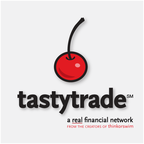
The tastytrade network
Summary: The tastytrade network teaches investors innovative, simple ways to trade stocks, options, and futures, take advantage of market volatility and build a successful portfolio. Tom Sosnoff leads an irreverent and playful band of floor traders who are showing America a new way to quickly find low risk, high return strategies in bullish, bearish and sideways markets.
- Visit Website
- RSS
- Artist: tastytrade
- Copyright: ℗ & © copyright 2013 - 2022 tastytrade. All Rights Reserved.
Podcasts:
Mike & Ryan discuss human nature, and how we are the driving force between increasing and decreasing implied volatility. As we buy options, we drive the price up which increases implied volatility and vice versa. How does realized volatility play a role in our stock market action, or lack there of? Tune in for a great discussion!
As each of us builds out our portfolios, the Greeks offer us [a unique view into the different characteristics](https://www.tastytrade.com/tt/shows/from-theory-to-practice/episodes/shepherding-greeks-06-21-2017) that our portfolios might exhibit. However, while two positions might both be [long delta](https://www.tastytrade.com/tt/shows/from-theory-to-practice/episodes/an-intuitive-understanding-of-delta-03-03-2016) or [positive theta](https://www.tastytrade.com/tt/shows/from-theory-to-practice/episodes/undercover-theta-04-06-2016), their degree of bullishness or decay might different drastically. This is always the case when examining defined-risk strategies relative to undefined-risk strategies. Mike, from Everyday Trader, joins us today to help flesh out this exact idea.
As each of us builds out our portfolios, the Greeks offer us [a unique view into the different characteristics](https://www.tastytrade.com/tt/shows/from-theory-to-practice/episodes/shepherding-greeks-06-21-2017) that our portfolios might exhibit. However, while two positions might both be [long delta](https://www.tastytrade.com/tt/shows/from-theory-to-practice/episodes/an-intuitive-understanding-of-delta-03-03-2016) or [positive theta](https://www.tastytrade.com/tt/shows/from-theory-to-practice/episodes/undercover-theta-04-06-2016), their degree of bullishness or decay might different drastically. This is always the case when examining defined-risk strategies relative to undefined-risk strategies. Mike, from Everyday Trader, joins us today to help flesh out this exact idea.
Liz and Jenny talk through the study that James brought in last week about double calendars and place one in SPY. Then on the heels of the Twitter segment, they go through the account and close every short option that is .10 or under.
Today's Calling All Millionaires segment covers Diagonals, AKA free longs! Liz and Jenny talk through how to place a diagonals with the intent of being left with a free long option to protect the existing position.
Today's Calling All Millionaires segment covers Diagonals, AKA free longs! Liz and Jenny talk through how to place a diagonals with the intent of being left with a free long option to protect the existing position.
Tweeting Live with LIZ & JNY - July 12, 2017
The LIZ & JNY Show - July 12, 2017
Quant HC is a Chicago-based, health-tech start-up which works in predictive algorithms and analytics for clinical workflows. Physicians and hospitals have better insight into a patient's care using their probability and risk factoring data. Dr. Dana Edelson is the Founder and CEO of the company. She received her Doctor of Medicine degree from the Pritzker School of Medicine at the University of Chicago. [Learn more about Quant HC](http://www.quanthc.com/)
Quant HC is a Chicago-based, health-tech start-up which works in predictive algorithms and analytics for clinical workflows. Physicians and hospitals have better insight into a patient's care using their probability and risk factoring data. Dr. Dana Edelson is the Founder and CEO of the company. She received her Doctor of Medicine degree from the Pritzker School of Medicine at the University of Chicago. [Learn more about Quant HC](http://www.quanthc.com/)
Talkin' With Tom and Tony - July 12, 2017
Good Trade Bad Trade - July 12, 2017
We recently analyzed the performance of neutral double calendar spreads in SPX. The trades historically performed best when initiated in [Low IV](https://www.tastytrade.com/tt/learn/measuring-implied-volatility) and when [managed](https://www.tastytrade.com/tt/learn/managing-winners) early. But how did volatility move and potentially impact the trades at different management points? ### Study * 2005-Present, SPX * Double [Calendar Spread](https://www.tastytrade.com/tt/learn/calendar-spread) * 60 DTE, Long 40 [Delta](https://www.tastytrade.com/tt/learn/delta) Put, Long 40 Delta Call * 30 DTE, short same strike Put, short same strike Call * Managed winners at 10%, 25%, 50% * Analyzed: * SPY IV move between [order entry](https://www.tastytrade.com/tt/learn/order-entry-checklist) and trade management * Only considered trades that were successful ### Results * The moves in the VIX were, on average, positive when the trades were managed. * Increases in IV played a larger role in trade management when the trades were initiated in low IVR. * Ultimately, these spreads serve as strategy diversification within a net short premium portfolio.
We recently analyzed the performance of neutral double calendar spreads in SPX. The trades historically performed best when initiated in [Low IV](https://www.tastytrade.com/tt/learn/measuring-implied-volatility) and when [managed](https://www.tastytrade.com/tt/learn/managing-winners) early. But how did volatility move and potentially impact the trades at different management points? ### Study * 2005-Present, SPX * Double [Calendar Spread](https://www.tastytrade.com/tt/learn/calendar-spread) * 60 DTE, Long 40 [Delta](https://www.tastytrade.com/tt/learn/delta) Put, Long 40 Delta Call * 30 DTE, short same strike Put, short same strike Call * Managed winners at 10%, 25%, 50% * Analyzed: * SPY IV move between [order entry](https://www.tastytrade.com/tt/learn/order-entry-checklist) and trade management * Only considered trades that were successful ### Results * The moves in the VIX were, on average, positive when the trades were managed. * Increases in IV played a larger role in trade management when the trades were initiated in low IVR. * Ultimately, these spreads serve as strategy diversification within a net short premium portfolio.
Expected move can either be calculated by using the expected move formula, or by looking at the strikes of the 16 [delta](https://www.tastytrade.com/tt/learn/delta) call and 16 delta put. By using the formula, we get a symmetric expected move, but by using the [strikes](https://www.tastytrade.com/tt/learn/strike-price), we get a skewed expected move. When comparing the two, we see that the stock price stays in the expected range calculated using the *formula* more often than by using strikes. Both equations overstate the expected move, but using the strikes is more accurate. For more details on this metric and how we use it when setting up our strategies, tune in to the segment.